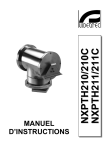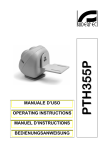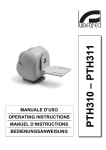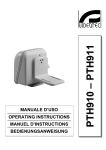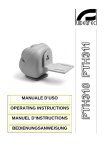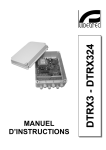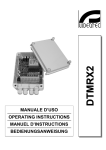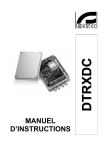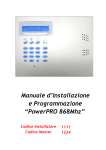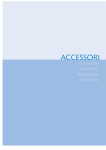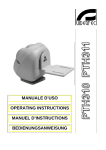Download Manuel d`instruction
Transcript
MANUALE D’USO --------------------------------------------------------------------------------------------------------------------------------------------------------- OPERATING INSTRUCTIONS --------------------------------------------------------------------------------------------------------------------------------------------------------- MANUEL D’INSTRUCTIONS --------------------------------------------------------------------------------------------------------------------------------------------------------- BEDIENUNGSANWEISUNG MANUALE D’USO INDICE INDICE .................................................................................................................................................................................... 1 INTRODUZIONE..................................................................................................................................................................... 2 Contenuto dell’imballo ................................................................................................................................................................................2 Cosa contiene questo manuale ..................................................................................................................................................................2 Convenzioni tipografiche ............................................................................................................................................................................2 NORME DI SICUREZZA ........................................................................................................................................................ 2 DATI DI MARCATURA .......................................................................................................................................................... 3 DESCRIZIONE DEI BRANDEGGI NXPTH............................................................................................................................ 3 Caratteristiche ............................................................................................................................................................................................3 Apparecchi compatibili................................................................................................................................................................................3 INSTALLAZIONE ................................................................................................................................................................... 3 Apertura dell’imballaggio ............................................................................................................................................................................3 Controllo della marcatura ...........................................................................................................................................................................3 REGOLAZIONE DEI BRANDEGGI NXPTH .......................................................................................................................... 4 CONNETTORI E COLLEGAMENTI....................................................................................................................................... 5 Esempio di installazione .............................................................................................................................................................................5 Cavi ............................................................................................................................................................................................................6 Collegamento del brandeggio alle unità di comando ..................................................................................................................................6 Collegamento del brandeggio al ricevitore DTRX3/DTMRX2 .................................................................................................................6 Collegamento del Preset al ricevitore DTRX3 ........................................................................................................................................7 ACCENSIONE E SPEGNIMENTO......................................................................................................................................... 7 MANUTENZIONE ................................................................................................................................................................... 7 RISOLUZIONE DI PROBLEMI............................................................................................................................................... 7 CARATTERISTICHE TECNICHE .......................................................................................................................................... 8 Meccanica ..................................................................................................................................................................................................8 Generali......................................................................................................................................................................................................8 Caratteristiche elettriche.............................................................................................................................................................................8 Dimensioni..................................................................................................................................................................................................8 Il produttore declina ogni responsabilità per eventuali danni derivanti da un uso improprio delle apparecchiature menzionate in questo manuale; si riserva inoltre il diritto di modificarne il contenuto senza preavviso. Ogni cura é stata posta nella raccolta e nella verifica della documentazione contenuta in questo manuale: tuttavia il produttore non può assumersi alcuna responsabilità derivante dall’utilizzo della stessa. Lo stesso dicasi per ogni persona o società coinvolta nella creazione e nella produzione di questo manuale. Pag. 1 MNNXPTH4403 Introduzione Contenuto dell’imballo • 1 brandeggio NXPTH • 1 sacchetto dotazione viteria • 1 manuale d’uso Alla consegna del prodotto verificare che l’imballo sia integro e non abbia segni evidenti di cadute o abrasioni. In caso di evidenti segni di danno all’imballo contattare immediatamente il fornitore. Controllare che il contenuto sia rispondente alla lista del materiale sopra indicata. Cosa contiene questo manuale In questo manuale sono descritti i brandeggi della serie NXPTH, con le particolari procedure di installazione, configurazione e utilizzo. E’ necessario leggere attentamente questo manuale, in particolar modo il capitolo concernente le norme di sicurezza, prima di installare ed utilizzare il brandeggio. Convenzioni tipografiche Nel presente manuale si fa uso di diversi simboli grafici, il cui significato è riassunto di seguito: Rischio di scariche elettriche; togliere l’alimentazione prima di procedere con le operazioni, se non é espressamente indicato il contrario. L’operazione é molto importante per il corretto funzionamento del sistema: si prega di leggere attentamente la procedura indicata, ed eseguirla secondo le modalità previste. Descrizione delle caratteristiche del sistema: si consiglia di leggere attentamente per comprendere le fasi successive. Norme di sicurezza I brandeggi NXPTH sono conformi alle normative vigenti all’atto della pubblicazione del presente manuale per quanto concerne la sicurezza elettrica, la compatibilità elettromagnetica ed i requisiti generali. Si desidera tuttavia garantire gli utilizzatori (tecnico installatore e operatore) specificando alcune avvertenze per operare nella massima sicurezza: • L’installazione dell’apparecchio (e dell’intero impianto di cui esso fa parte) deve essere effettuata da personale tecnico adeguatamente qualificato • L’apparecchio deve essere aperto soltanto da personale tecnico qualificato. La manomissione dell’apparecchio fa decadere i termini di garanzia • Collegare ad un dispositivo corrispondente come indicato sulle etichette di marcatura (vedere il successivo capitolo Dati di marcatura) • Prima di spostare o effettuare interventi tecnici sull’apparecchio, disinserire i cavi di collegamento con altri dispositivi • Non utilizzare cavi di tensione con segni di usura o invecchiamento, in quanto rappresentano un grave pericolo per l’incolumità degli utilizzatori • Non utilizzare l’apparecchio in presenza di sostanze infiammabili • Non permettere l’uso dell’apparecchio a bambini o incapaci • Accertarsi che l’apparecchio sia fissato in maniera solida e affidabile • L’apparecchio si considera disattivato soltanto quando i cavi di collegamento con altri dispositivi sono stati rimossi • Per l’assistenza tecnica rivolgersi esclusivamente al personale tecnico autorizzato • Conservare con cura il presente manuale per ogni futura consultazione Pag. 2 MNNXPTH4403 Dati di marcatura Sui brandeggi NXPTH sono riportate due etichette conformi alla marcatura CE. La prima etichetta contiene: • Codice di identificazione del modello (Codice a barre Extended 3/9 ) • Tensione di alimentazione (Volt) • Frequenza (Hertz) • Consumo (Watt) La seconda etichetta indica il numero di serie del modello (codice a barre Extended 3/9) All’atto dell’installazione controllare se le caratteristiche di alimentazione del brandeggio corrispondono a quelle richieste. L’uso di apparecchi non idonei può portare a gravi pericoli per la sicurezza del personale e dell’impianto. Descrizione dei brandeggi NXPTH L’unità NXPTH è un brandeggio verticale e orizzontale appositamente studiato per essere utilizzato in ambienti esterni, entrambi i modelli sono dotati di funzione Preset. Caratteristiche • • • • • • Movimento sul piano orizzontale (Pan): da 0 a 355°. Velocità: 5° al secondo Movimento sul piano verticale (Tilt): da 0 a 355°. Velocità: 2,8° al secondo Costruzione in acciaio inox Aisi 316 Chiusura completamente sigillata per operare sia in ambiente interno che esterno Temperatura di funzionamento da -20°C a +55°C PRESET per entrambe le versioni Apparecchi compatibili La funzionalita’ dei brandeggi e’ garantita solo se collegati a : • Ricevitore di comandi DTRX3: ricevitore digitale a 17 funzioni, consente il controllo a distanza di un brandeggio motorizzato, di lavavetri e pompa, e di 4 contatti ausiliari. È indirizzabile singolarmente fino a 999 unità. Permette la gestione di max 14 posizioni di preset, richiamabili in ciclata con la funzione patrol. • Miniricevitore di comandi DTMRX2/DTMRX224: ricevitore digitale a 12 funzioni, consente il controllo di base di un brandeggio motorizzato (orizzontale e verticale, ottiche, autopan, ausiliare). Indirizzabile singolarmente fino a 99 unità. Installazione La fase di installazione deve essere effettuata solo da personale tecnico qualificato. Le seguenti procedure sono da effettuare in assenza di alimentazione, se non diversamente indicato. Apertura dell’imballaggio Se l’imballo non presenta evidenti difetti (dovuti a cadute o abrasioni anomale), procedere al controllo del materiale in esso contenuto, secondo la lista fornita al paragrafo Contenuto dell’imballo al capitolo Introduzione. I materiali d’imballo sono costituiti interamente da materiale riciclabile. Sarà cura del tecnico installatore smaltirli secondo le modalità di raccolta differenziata o comunque secondo le norme vigenti nel Paese di utilizzo. Controllo della marcatura Prima di procedere con l’installazione controllare se il materiale fornito corrisponde alle specifiche richieste, esaminando le etichette di marcatura, secondo quanto descritto al capitolo Dati di marcatura. Non effettuare per nessun motivo alterazioni o collegamenti non previsti in questo manuale: l’uso di apparecchi non idonei può portare a gravi pericoli per la sicurezza del personale e dell’impianto. Pag. 3 MNNXPTH4403 Regolazione dei brandeggi NXPTH ATTENZIONE: Non posizionare il brandeggio manualmente poichè questa operazione può danneggiare seriamente gli ingranaggi. Svitare le 4 viti del coperchio e aprire il brandeggio Fig.1 Identificare le camme per la regolazione della corsa verticale e di quella orizzontale Regolare l’ampiezza di apertura delle camme secondo l’angolo desiderato, forzandole leggermente (non servono attrezzi, il movimento è a frizione) Fig.2 Regolazione di fabbrica dell’angolo di rotazione del brandeggio: Le camme di finecorsa sono regolate in modo simmetrico rispetto al centro dei microswitches con un angolo di circa A=90°. Fig.3 Regolazione dell’angolo di rotazione del brandeggio: Le camme di finecorsa possono essere spostate ognuna con un angolo massimo B=180° rispetto al centro dei microswitches. ATTENZIONE: Un angolo B>180° comporta un danneggiamento del potenziometro! Fig.4 Pag. 4 MNNXPTH4403 Regolazione dell’angolo di rotazione del brandeggio: Si può ottenere un angolo di rotazione massimo di circa A=350°. Ne risulta un angolo morto non coperto dal brandeggio tratteggiato in Fig.5. Nel caso che tale angolo morto risulti interno al campo di visualizzazione desiderato è necessario riportare le camme nella configurazione originale di Fig.3 e ruotare la posizione di fissaggio del brandeggio sulla staffa di supporto (es. Fig.6). Quindi effettuare nuovamente il settaggio come in Fig.4. Fig.5 Fig.6 Connettori e collegamenti La procedura di installazione deve essere effettuata soltanto da personale tecnico qualificato: il collegamento non corretto delle varie periferiche può comportare l’isolamento della tastiera dal resto del sistema. Esempio di installazione Un operatore con più monitor, con controllo di una serie di brandeggi in configurazione a cascata. MATERIALE IMPIEGATO Tastiera di controllo: • 1 tastiera di controllo Gestione del video: • 1 matrice video • 2 monitor • 4 telecamere • Gestione della telemetria: • 4 ricevitori • 4 brandeggi NXPTH Matrice video Tastiera Pag. 5 MNNXPTH4403 Cavi Negli schemi d’esempio sono stati utilizzati diversi tipi di tratto per indicare cavi di diversa funzione: cavo video: coassiale RG 59 o cavo equivalente. cavo multipolare: Stabilire il numero finale di cavi, seguendo le indicazioni seguenti: 6 fili per la movimentazione del brandeggio: destra, sinistra, alto, basso, comune, terra 6 fili di controllo per ottiche ad inversione di polarità (zoom, focus, iris) 4 fili di controllo per ottiche a filo comune (zoom, focus, iris) 2 fili per l’ ausiliare 4 fili per il Preset Nota: è consigliato l’utilizzo di differenti cavi multipolari per le funzioni in bassa tensione ed in alta tensione. Sezione minima consigliata: 0,56 mm.² (AWG 20) per fili in alta tensione (brandeggio) 0,34 mm.² (AWG 22) per fili in bassa tensione (ottica, ausiliare, preset) Attenzione! Il cavo multipolare del preset non deve essere lo stesso del brandeggio. Collegamento del brandeggio alle unità di comando Nella figura seguente identificare la morsettiera J1, sulla scheda relativa al movimento orizzontale, per il collegamento del brandeggio alle unità di comando: Collegamento del brandeggio al ricevitore DTRX3/DTMRX2 Fig. 1A Fig. 1B ATTENZIONE: prima di eseguire i collegamenti assicurarsi che la tensione in uscita dal ricevitore corrisponda alla tensione del brandeggio (Fare riferimento ai dati di marcatura del brandeggio e al manuale DTRX3/DTMRX2). Dove Agire: morsettiera J1 sulla scheda inferiore del brandeggio (vedi figura 1A) o connettore 6+1 poli (vedi figura 1B), morsettiera del ricevitore (vedi manuale DTRX3/DTMRX2) Impostazioni: collegare la morsettiera J1 o il connettore 6+1 poli del brandeggio a quella del ricevitore secondo la tabella seguente Collegamento al ricevitore Morsetto J1 (brandeggio) Connettore 6+1 poli COM DOWN UP RIGHT LEFT Com Down Up Right Left 1 2 3 4 5 EARTH Pag. 6 MNNXPTH4403 Collegamento del Preset al ricevitore DTRX3 Dove Agire: morsettiera J1 sulla scheda relativa al movimento verticale del brandeggio (vedi figura 2A) o connettore 3+1 poli (vedi figura 2B), morsettiera preset (vedi manuale DTRX3) Impostazioni: collegare la morsettiera J1 o il connettore 3+1 poli in uscita dal brandeggio alla morsettiera preset del ricevitore DTRX3 secondo la tabella seguente. Fig. 2A Fig. 2B Collegamento al ricevitore VCC PAN TILT GND Morsetto J1 sul brandeggio Vcc Pan Tilt Gnd Connettore 3+1 poli 1 2 3 Accensione e spegnimento Prima di fornire alimentazione: • controllare se il materiale fornito corrisponde alle specifiche richieste, esaminando le etichette di marcatura, secondo quanto descritto al capitolo Descrizione della marcatura. • controllare che il brandeggio NXPTH e gli altri componenti dell’impianto siano chiusi e sia quindi impossibile il contatto diretto con parti in tensione. • accertarsi che tutte le parti siano fissate in maniera solida ed affidabile • controllare che le fonti di alimentazione ed i cavi di collegamento siano in grado di sopportare il consumo del sistema Manutenzione I brandeggi NXPTH non necessitano di particolare manutenzione. Si raccomanda di fissarlo saldamente ad una una base solida, con i cavi di alimentazione e di collegamento in posizione tale da non essere causa di intralcio all’operatore. Risoluzione di problemi I brandeggi NXPTH sono caratterizzati da una notevole facilità d’uso, ma ciononostante possono insorgere dei problemi sia in fase di installazione o durante l’uso. Problema Il ricevitore funziona, ma il brandeggio non risponde Il brandeggio risponde ai comandi ma il PRESET non funziona Possibile causa Collegamenti errati La tensione fornita dall’unità di comando non è quella richiesta dal brandeggio Collegamenti errati Pag. 7 Intervento correttivo Controllare i collegamenti tra brandeggio e unità di comando Controllare i dati di marcatura dell’unità di comando e del brandeggio Controllare i collegamenti tra brandeggio ed il ricevitore DTRX3 MNNXPTH4403 Caratteristiche tecniche Meccanica Pan Velocità Coppia Tilt Velocità Coppia Carico massimo Protezione Potenziometr 0-355° movimento nel piano orizzontale 5° al secondo 35 Nm al voltaggio specificato 0-355° movimento nel piano verticale 2,8° al secondo 63 Nm al voltaggio specificato 40 Kg (88 lb) - (bilanciato) IP 67 Lineare multigiro (10 giri) Generali Costruzione Finitura Temperatura Dimensioni Peso Diametro cavo Carpenteria in acciaio inox Aisi 316; Brillantatura esterna da -20°C a +55°C (da -4°F a +131°F) 164x250x280 mm 15 Kg (33 lb) 10 mm Caratteristiche elettriche Alimentazione NXPTH210/NXPTH210C NXPTH211/NXPTH211C 230 V~ 50/60 Hz 13+13 W 24 V~ 50/60 Hz 13+13 W Cablaggio 6 fili 0,56 mm.² (AWG 20) (Funzioni: sinistra, destra, alto, basso, comune, Terra) 4 fili 0,34 mm.² (AWG 22) (Preset) Dimensioni Pag. 8 MNNXPTH4403 OPERATING INSTRUCTIONS INDEX INDEX ..................................................................................................................................................................................... 1 INTRODUCTION .................................................................................................................................................................... 2 Packing contents ........................................................................................................................................................................................2 Contents of this Manual..............................................................................................................................................................................2 Typographic conventions............................................................................................................................................................................2 SAFETY RULES..................................................................................................................................................................... 2 IDENTIFICATION DATA ........................................................................................................................................................ 3 DESCRIPTION OF NXPTH PAN & TILT MOTORS .............................................................................................................. 3 Features .....................................................................................................................................................................................................3 Appliances compatible with NXPTH ...........................................................................................................................................................3 INSTALLATION...................................................................................................................................................................... 3 Unpacking ..................................................................................................................................................................................................3 Check of identification data ........................................................................................................................................................................3 ADJUSTMENT OF NXPTH PAN & TILT MOTORS .............................................................................................................. 4 CONNECTORS AND CONNECTIONS.................................................................................................................................. 5 Installation example....................................................................................................................................................................................5 Cables ........................................................................................................................................................................................................6 Pan & tilt connection to control units...........................................................................................................................................................6 Pan & tilt connection to DTRX3/DTMRX2 receiver.................................................................................................................................6 Preset connection to DTRX3 receiver ....................................................................................................................................................7 SWITCHING ON AND OFF.................................................................................................................................................... 7 MAINTENANCE ..................................................................................................................................................................... 7 PROBLEM SOLUTION .......................................................................................................................................................... 7 SPECIFICATIONS.................................................................................................................................................................. 8 Mechanics ..................................................................................................................................................................................................8 General.......................................................................................................................................................................................................8 Electric features..........................................................................................................................................................................................8 Dimensions.................................................................................................................................................................................................8 The manufacturer declines all responsibility for any damage caused by an improper use of the appliances mentioned in this manual; furthermore, the manufacturer reserves the right to modify its contents without any prior notice. The documentation contained in this manual has been collected with great care: the manufacturer, however, cannot take any liability for its use. The same thing can be said for any person or company involved in the creation and production of this manual. Pag. 1 MNNXPTH4403 Introduction Packing contents • 1 pan & tilt motor NXPTH • 1 bag with bolts and screws • 1 instruction manual After the delivery, check that the packing is not damaged and shows no evident signs of falls or abrasions. Should this be so, contact immediately the supplier. Check that the contents correspond to the above-mentioned list of materials. Contents of this Manual • This manual describes NXPTH pan & tilt motors, together with their specific procedures of installation, configuration and use. Read this manual carefully, in particular the chapter concerning the safety rules, before installing and using the pan & tilt motor. Typographic conventions Different graphic symbols are used in this manual, the meaning of which is here described: Hazard of electric shock; disconnect the power supply before proceeding, if not otherwise specified. The operation is very important for the correct working of the system: read carefully the procedure indicated, and carry it out according to the required modalities. Description of system features: read carefully to understand the following phases. Safety rules NXPTH pan & tilt motors comply with the normative laws in force at the time of editing of this manual, concerning electric safety, electromagnetic compatibility and general requirements. Anyway, in order to ensure the users (installer technician and operator), the following warnings are specified for safety’s sake: • The appliance (and the complete system, which it belongs to) must be installed only by qualified technical staff • The appliance must be opened only by qualified technical staff. The tampering of the appliance may void the guarantee terms. • Connect to a device corresponding to the specifications indicated on the data plate (see next chapter Identification data) • Before any shifting or technical operations on the appliance, the cables connected to other appliances have been removed • Do not use voltage cables showing wear or ageing, since they may seriously compromise the users’ safety • Do not use the appliance in the presence of inflammable substances • Do not allow children or people not familiar with the appliance to use it • Make sure the appliance is fixed in a solid and reliable way • The appliance is completely off-line only when the cables connected to other appliances have been removed • For after-sale service call only authorised technical staff • Keep this manual close to hand for any future reference Pag. 2 MNNXPTH4403 Identification data On NXPTH pan & tilt motors there are two plates complying with EC specifications. The first plate includes: • Model identification code (Extended bar code 3/9 ) • Mains voltage (Volt) • Frequency (Hertz) • Power consumption (Watt) The second plate shows the model serial number (Extended bar code 3/9) When installing the appliance, check that the power supply specifications of the pan & tilt motor correspond to those required. The use of improper appliances may seriously compromise the safety of the personnel and the installation. Description of NXPTH pan & tilt motors NXPTH unit is a vertical and horizontal pan & tilt motor, expressly projected for outdoor installations; both models are equipped with the Preset function. Features • • • • • • Horizontal movement (Pan): from 0 to 350°. Speed: 5° per second Vertical movement (Tilt): from 0 to 355°. Speed: 2,8° per second Construction in Aisi 316 stainless steel Completely sealed closing for indoor/outdoor operation Operating temperature from -20°C to +55°C (from -4°F to 131°F) PRESET for both models Appliances compatible with NXPTH The working of pan & Tilt motors is guaranteed only if connected to: • DTRX3 receiver driver: 17-function digital receiver, allowing the remote control of pan & tilt motors, wiper and wash, and 4 auxiliary contacts. It can be individually addressed up to 999 units. It allows the management of max. 14 preset positions, which are recalled in the switching cycle by the patrol function. • DTMRX2/DTMRX224 minireceiver driver: 12-function digital receiver, allowing the control of pan & tilt motors (horizontal and vertical, zoom lenses, autopan). It can be individually addressed up to 99 units. Installation The installation must be carried out only by qualified technical staff. The following procedures must be carried out with power supply off, if not otherwise specified. Unpacking If the packing shows no relevant defects (due to falls or anomalous abrasions), check the material contained, according to the list given at paragraph Packing contents chapter Introduction. The packing materials can be completely recycled. The installer technician is required to dispose of them according to the differentiated collecting modalities or ,anyway, according to the normative laws in force in the Country of use. Check of identification data Before installing the appliance, check that the material supplied corresponds to the specifications indicated on the data plate, following the chapter Identification data. Do not carry out any modification or connections which are not provided for in this manual: the use of improper appliances may seriously compromise the safety of the personnel and the installation. Pag. 3 MNNXPTH4403 Adjustment of NXPTH pan & tilt motors CAUTION: Do not position the pan & tilt motor manually, since this operation may seriously damage the gears. Unscrew the 4 cover screws and open the pan & tilt motor Fig.1 Identify the cams for vertical and horizontal stroke adjustment Adjust the opening of the cams according to the angle wished, by forcing them slightly (no tools are necessary, it is a friction movement) Fig.2 Factory regulation of the rotating angle of the pan & tilt: The limit switch cams are symmetrical set in respect to the center of the microswitches with an angle of about A=90°. Fig.3 Regulation of the rotating angle of the pan & tilt: The limit switch cams can be moved each one with an angle maximum B=180° in respect to the center of the microswitches. CAUTION: An angle B>180° seriously damage the potentiometer! Fig.4 Pag. 4 MNNXPTH4403 Regulation of the rotating angle of the pan & tilt: The maximum reachable rotating angle is of about A=350°. For this reason there is a “dead angle” not covered from the pan & tilt visible in Fig.5. If this “dead angle” is inside the desired field of vision it is necessary to move again the limit switch cams on the original configuration of Fig.3 and rotate the fixing position of the pan & tilt on its bracket (see Fig.6). Then regulate again the rotating angle as described in Fig.4. Fig.5 Fig.6 Connectors and connections The installation must be carried out only by qualified technical staff: an improper connection of the peripheral units may cause the keyboard to be isolated from the rest of the system. Installation example One operator with more monitors, who controls a series of pan & tilt motors in cascade configuration. MATERIAL USED Control keyboard: • 1 control keyboard Video handling: • 1 video matrix • 2 monitors • 4 cameras Video matrix • Telemetry handling: • 4 receivers • 4 NXPTH pan & tilt motors Keyboard Pag. 5 MNNXPTH4403 Cables Different types of stroke have been used in the previous examples, in order to indicate cables with different functions: video cable: RG 59 coaxial cable or equivalent cable multipolar cable: Fix the final numbers of wires according to the following directions: 6 wires for the motion of the positioning device: right, left, up, down, autopan, common, ground 6 wires for the control of polarity reversal lenses (zoom, focus, iris) 4 wires for the control of common wire lenses (zoom, focus, iris) 2 wires for the auxiliary device 4 wires for the preset function Note: We recommend the use of different multipolar cables for high tension and low tension functions. Minimum section area recommended: 0.56 mm.² (AWG 20) for high tension wires (positioning device) 0.34 mm.² (AWG 22) for low tension wires (lens, auxiliary device, preset) Warning! The preset multipolar cable must not be the same used for the pan & tilt motor. Pan & tilt connection to control units In the following drawing, identify the terminal block J1 in the horizontal movement circuit for the pan & tilt connection to the control units: Pan & tilt connection to DTRX3/DTMRX2 receiver Fig. 1A Fig. 1B WARNING: before the connection, make sure that the output voltage of the receiver corresponds to pan & tilt voltage (refer to the identification data of the pan & tilt motor and to DTRX3/DTMRX2 manual). Where to operate: J1 terminal block in the lower printed circuit of the pan & tilt motor (see drawing 1A) or 6+1 poles connector (see drawing 1B), terminal block of the receiver (see DTRX3/DTMRX2 manual) Adjustments: connect the terminal block J1 of the pan & tilt motor to that of the receiver according to the following table Connection to the receiver Terminal block J1 (Pan & Tilt) 6+1 poles connector COM DOWN UP RIGH LEFT Com Down Up Right Left 1 2 3 4 5 earth Pag. 6 MNNXPTH4403 Preset connection to DTRX3 receiver Where to operate: J1 terminal block in the horizontal movement circuit of the pan & tilt motor (see drawing 2A) or 3+1 poles connector (see drawing 2B), terminal block of preset (see DTRX3 manual) Adjustments: connect the J1 terminal block of the pan & tilt motor to the terminal block of the DTRX3 preset according to the following table: Fig. 2A Connection to DTRX3 receiver Vcc Pan Tilt Gnd Fig. 2B Terminal block J1 on Pan & Tilt Vcc Pan Tilt Gnd 3+1 poles connector 1 2 3 Switching on and off Before connecting the appliance: • check that the material supplied corresponds to the specifications indicated on the data plate, following the chapter Identification data • check that NXPTH pan & tilt motor and the other components of the installation are closed in order to avoid direct contact with energized parts. • make sure that all the parts are fixed in a solid and reliable way • check that the electrical capacity and the connection cables will support the system power consumption Maintenance NXPTHpan & tilt motors do not need a special maintenance. Make sure they always rest on a solid base, and that the power supply and connection cables do not hinder the operator. Problem solution Even if NXPTH pan & tilt motors are very easy to use, some problems may arise during installation, configuration or use. Problem Possible cause The receiver is working, but Incorrect connections the pan & tilt motor does not respond The voltage supplied by the control unit is different from that required by the pan & tilt motor The pan & tilt motor Incorrect connections responds to the controls but the PRESET does not work Pag. 7 Remedy Check the connections between the pan & tilt motor and the control unit Check the identification data of the control unit and of the pan & tilt motor Check the connections between the pan & tilt motor and the DTRX3 receiver MNNXPTH4403 Specifications Mechanics Pan Speed Torque Tilt Speed Torque Maximum load Protection Potentiometer 0-355° horizontal plane movement 5° per second 35 Nm at specified voltage 0-355° vertical plane movement 2,8° per second 63 Nm at specified voltage 40 Kg (88 lb) (balanced) IP 67 Linear Multiturns (10 turns) General Construction Finish Temperature Dimensions Weight Cable diameter carpentry in Aisi 316 stainless steel external polishing from -20°C to +55°C (from -4°F to 131°F) 164x250x280 mm 15 Kg (33 lb) 10 mm Electric features Power Supply NXPTH210/NXPTH210C NXPTH211/NXPTH211C 230 V~ 50/60 Hz 13+13 W 24 V~ 50/60 Hz 13+13 W Wiring 6 cables 0.56mm.² (AWG 20) (Functions: left, right, up, down, common and earth). 4 cables 0.34mm.² (AWG 22) (Preset) Dimensions Pag. 8 MNNXPTH4403 MANUEL D’INSTRUCTIONS INDEX INDEX ..................................................................................................................................................................................... 1 INTRODUCTION .................................................................................................................................................................... 2 Contenu de l’emballage..............................................................................................................................................................................2 Contenu de ce manuel ...............................................................................................................................................................................2 Conventions typographiques ......................................................................................................................................................................2 NORMES DE SÉCURITÉ ....................................................................................................................................................... 2 Caractéristiques techniques .......................................................................................................................................................................3 DESCRIPTION DES TOURELLES NXPTH........................................................................................................................... 3 Caractéristiques..........................................................................................................................................................................................3 Appareils compatibles ................................................................................................................................................................................3 INSTALLATION...................................................................................................................................................................... 3 Déballage ...................................................................................................................................................................................................3 Contrôle des caractéristiques techniques ...................................................................................................................................................3 RÉGLAGE DES TOURELLES NXPTH.................................................................................................................................. 4 CONNECTEURS ET RACCORDEMENTS............................................................................................................................ 5 Exemple d’installation.................................................................................................................................................................................5 Câbles ........................................................................................................................................................................................................6 Raccordement de la tourelle aux unités de commande ..............................................................................................................................6 Raccordement de la tourelle au récepteur DTRX3/DTMRX2 .................................................................................................................6 Raccordement de la Préselection au récepteur DTRX3 .........................................................................................................................7 ALLUMAGE ET COUPURE................................................................................................................................................... 7 ENTRETIEN............................................................................................................................................................................ 7 RÉSOLUTION DES PROBLÈMES ........................................................................................................................................ 7 DONNÉES TECHNIQUES ..................................................................................................................................................... 8 Mécanique..................................................................................................................................................................................................8 Données générales ....................................................................................................................................................................................8 Données électriques...................................................................................................................................................................................8 Dimensions.................................................................................................................................................................................................8 Le producteur décline toute responsabilité pour les dommages éventuels dus à une utilisation non appropriée des appareils mentionnés dans ce manuel; on réserve en outre le droit d’en modifier le contenu sans préavis. La documentation contenue dans ce manuel a été rassemblée et vérifiée avec le plus grand soin: cependant, le producteur ne peut pas s’assumer aucune responsabilité dérivante de l’emploi de celle-là. La même chose vaut pour chaque personne ou société impliquées dans la création et la production de ce manuel. Pag. 1 MNNXPTH4403 Introduction Contenu de l’emballage • 1 tourelle NXPTH • 1 sachet de vis • 1 manuel d’emploi Lors de la livraison du produit, vérifier si l’emballage est correct et s’il n’a pas subi des signes évidents de chutes ou de choc. Si l’emballage présente des signes évidents de dommage, contacter immédiatement le transporteur. Vérifier que le contenu correspond à la liste du matériel indiqué ci-dessus. Contenu de ce manuel Dans ce manuel on décrit les tourelles de la série NXPTH, et les procédures particulières d’installation, configuration et emploi. Il est nécessaire de lire attentivement ce manuel, surtout le chapitre concernant les normes de sécurité, avant d’installer et employer la tourelle. Conventions typographiques Dans ce manuel on emploie des symboles graphiques différents, dont le sens est résumé ci-dessous: Risque de décharge électrique; couper l’alimentation avant de procéder avec toute opération, si le contraire n’est pas expressément indiqué. L’opération est très importante pour le fonctionnement correct du système: lire attentivement la procédure indiquée, et l’exécuter suivant les modalités prévues. Description des caractéristiques du système: lire attentivement pour comprendre les phases suivantes. Normes de sécurité La tourelle NXPTH est conforme aux normes en vigueur au moment de la publication de ce manuel pour ce qui concerne la sécurité électrique, la compatibilité électromagnétique et les conditions requises générales. On désire toutefois garantir les utilisateurs (technicien installateur et opérateur) en précisant certaines instructions pour opérer en toute sécurité: • L’installation de l’appareil (et du système complet dont il fait partie) doit être effectuée par une personne qualifiée du point de vue technique. • L’appareil doit être ouvert seulement par un personnel technique qualifié. L’altération de l’appareil fait déchoir les termes de garantie • Raccorder à un appareil en suivant les indications des plaques des caractéristiques techniques (voir le chapitre suivant Caractéristiques techniques) • Avant de déplacer ou effectuer des interventions techniques sur l’appareil, débrancher les câbles de raccordement avec d’autres dispositifs. • Ne pas employer de câbles de tension avec signes d’usure ou vieillissement, parce qu’ils peuvent compromettre sérieusement la sécurité des utilisateurs. • Ne pas employer l’appareil en présence de substances inflammables • Ne pas laisser des enfants ou des personnes non qualifiées utiliser l’appareil • Vérifier si l’appareil est fixé de façon solide et fiable • L’appareil est désactivé seulement quand les câbles de raccordement avec d’autres dispositifs ont été enlevés. • Pour le service après-vente s’adresser exclusivement à personnel technique autorisé. • Conserver soigneusement ce manuel pour toute consultation ultérieure Pag. 2 MNNXPTH4403 Caractéristiques techniques Sur les tourelles NXPTH il y a deux plaques conformes aux caractéristiques techniques CE. La première plaque contient: • Code d’identification du modèle (Code à barre EXT3/9 ) • Tension d’alimentation (Volt) • Fréquence (Hertz) • Max. consommation (Watt) La deuxième plaque indique le numéro de série du modèle (Code à barre EXT3/9) Lors de l’installation vérifier que les caractéristiques d’alimentation de la tourelle correspondent aux caractéristiques requises. L’emploi d’appareils non appropriés peut compromettre sérieusement la sécurité du personnel et de l’installation. Description des tourelles NXPTH L’unité NXPTH est une tourelle verticale et horizontale, spécialement conçue pour être employée à l’extérieur; tous les deux modèles sont équippés avec la fonction preset. Caractéristiques • • • • • • Mouvement horizontal ( Pan ): de 0 à 355°. Vitesse: 5° / sec Mouvement vertical ( Tilt ): de 0 à 355°. Vitesse: 2,8° / sec Construction en acier inox Aisi 316 Fermeture complètement scellée pour installations intérieures et extérieures Température de fonctionnement de -20°C à +55°C ( de -4°F à 131°F ) PRÉSELECTION pour tous les deux modèles Appareils compatibles La fonctionalité des tourelles est garantie seulement s’ils sont connectés à: • Récepteur de commandes DTRX3: récepteur numérique à 17 fonctions, il permet le contrôle à distance d’une tourelle motorisée, d’essuie-glace et pompe, et de 4 contacts auxiliaires. Individuellement adressable jusqu’à 999 unités. Il peut gerer 14 positions de préselection au max. qui peuvent être rappelées en cycle de commutation par la fonction patrol. • Minirécepteur de commandes DTMRX2/DTMRX224: récepteur numérique à 12 fonctions, il permet le contrôle de base d’une tourelle motorisée (horizontale et verticale, objectif, autopan). Adressable individuellement jusqu’à 99 unités. Installation L’installation doit être effectuée seulement par un technicien qualifié. Les procédures suivantes sont effectuées hors tension, sauf avis contraire. Déballage Si l’emballage ne présente pas d’évidents défauts dus à des chutes ou des chocs anormaux, procéder au contrôle du matériel contenu, suivant la liste fournie au chapitre Introduction, Contenu de l’emballage. L’emballage est entièrement fait de matériel recyclable. Le technicien installateur devra l’éliminer selon les modalités de recolte diversifiée ou en tout cas suivant les normes en vigueur dans le Pays d’emploi. Contrôle des caractéristiques techniques Avant d’installer l’appareil, vérifier que les caractéristiques techniques du matériel fourni, figurant sur les plaques, correspondent aux spécifications requises, en se rapportant au chapitre Caractéristiques techniques . Ne jamais effectuer de modifications ou de raccordements non prévus dans ce manuel: l’emploi d’appareils non appropriés peut compromettre sérieusement la sécurité des personnes et de l’installation. Pag. 3 MNNXPTH4403 Réglage des tourelles NXPTH ATTENTION: Ne pas forcer manellement l’orientation horizontale ou verticale sous peine de deteriorer le mecanisme de la tourelle et annuler la garantie. Dévisser les 4 vis du couvercle et ouvrir la tourelle. Fig.1 Identifier les cames pour le réglage de la course verticale et horizontale Régler l’ouverture des cames selon l’angle désiré, en les forçant légèrement (il n’y a pas besoin d’outils, c’est un mouvement à friction) Fig.2 Réglage effectué en usine de l'angle de rotation tourelle: Les cames de fin de course sont réglées de façon symétrique par rapport au centre des microinterrupteurs avec un angle d'environ A = 90°. Fig.3 Réglage de l'angle de rotation tourelle : Chacune des cames de fin de course peut être déplacée selon un angle maximal B = 180° par rapport au centre des micro-interrupteurs. ATTENTION: un angle B>180° entraînera l'endommagement du potentiomètre. Fig.4 Pag. 4 MNNXPTH4403 Réglage de l'angle de rotation tourelle : Un angle de rotation maximal de A = 350° environ est possible, et comporte un angle mort non couvert par la tourelle indiqué par la ligne hachurée de la Fig.5. Si cet angle mort se trouve à l'intérieur du champ d'affichage nécessaire, il est nécessaire de replacer les cames dans leur configuration originale (voir Fig.3), et de faire pivoter la position de fixation de la tourelle sur l'étrier de support (ex. Fig.6). Procéder à nouveau au réglage. comme indiqué à la Fig.4. Fig.5 Fig.6 Connecteurs et raccordements La procédure d’installation doit être effectuée seulement par personnel technique qualifié: un raccordement incorrect des différentes périphériques peut entraîner l’isolation du pupitre du reste du système. Exemple d’installation Un opérateur avec plusieurs moniteurs, qui contrôle une série de tourelles en configuration en cascade. MATERIEL EMPLOYÉ Pupitre de contrôle: • 1 pupitre Gestion du vidéo: • 1 matrice vidéo • 2 moniteurs • 4 caméras Matrice vidéo Gestion de la télémétrie: • 4 récepteurs • 4 tourelles NXPTH Pupitre Pag. 5 MNNXPTH4403 Câbles Dans les exemples, des traits différents ont été employés pour indiquer des câbles à fonctions diversifiées: câble vidéo: coaxial RG 59 ou câble équivalent câble multipolaire: Déterminer le nombre final de câbles, suivant les indications ci-dessous: 6 fils pour le mouvement de la tourelle: droite, gauche, haut, bas, autopan, commun, terre 6 fils de commande pour objectif fonctionnant par inversion de polarité (objectif, focus, iris) 4 fils de commande pour objectif fonctionnant par fil commun (objectif, focus, iris) 2 fils pour l’auxiliaire 4 fils pour la fonction de préselection Note: on conseille l’emploi de câbles multipolaires différents pour les fonctions en basse tension et haute tension. Section conseillée de minimum: 0,56 mm.² (AWG 20) pour fils en haute tension (tourelle) 0,34 mm.² (AWG 22) pour fils en basse tension (objectif, auxiliaire) Attention! Le câble multipolaire du preset ne doit pas être le même utilisé pour la tourelle. Raccordement de la tourelle aux unités de commande Dans la figure suivante, identifier le bornier J1 sur la carte du mouvement horizontal pour le raccordement de la tourelle aux unités de commande: Raccordement de la tourelle au récepteur DTRX3/DTMRX2 Fig. 1A Fig. 1B ATTENTION: avant d’effectuer les raccordements, vérifier si la tension en sortie du récepteur correspond à la tension de la tourelle (Se rapporter aux caractéristiques de la tourelle et au manuel DTRX3/DTMRX2). Où l’on doit agir : plaque à bornes J1 sur la carte infèrieure de la tourelle (voir figure 1A) ou connecteur 6+1 pôles (voir figure 1B), plaque à bornes du récepteur (voir manuel DTRX3/DTMRX2) Réglages: raccorder la plaque à bornes J1 de la tourelle à celle du récepteur selon le tableau suivant Raccordement au récepteur Borne J1 (tourelle) Connecteur avec 6+1 pôles COM DOWN UP RIGHT LETF Com Down Up Right Left 1 2 3 4 5 EARTH Pag. 6 MNNXPTH4403 Raccordement de la Préselection au récepteur DTRX3 Où l’on doit agir : bornier J1 sur la carte du mouvement verticale de la tourelle tourelle (voir figure 2A) ou connecteur 3+1 pôles (voir figure 2B), bornier de la préselection (voir manuel DTRX3) Réglages: raccorder le bornier J1 en sortie de la tourelle au bornier de la préselection du récepteur DTRX3 selon le tableau suivant. Fig. 2A Fig. 2B Raccordement au récepteur DTRX3 VCC PAN TILT GND Borne J1 sur la tourelle Connecteur 3+1 pôles Vcc Pan Tilt Gnd 1 2 3 Allumage et coupure • • • • Avant d’alimenter l’appareil: vérifier que le matériel fourni correspond aux spécifications requises, suivant les plaques des caractéristiques techniques, en se rapportant au chapitre Caractéristiques techniques. vérifier si la tourelle NXPTH et les autres composantes de l’installation sont fermées afin d’éviter le contact direct avec parties sous tension vérifier si toutes les parties sont fixées de façon solide et fiable vérifier si les sources d’alimentation et les câbles de raccordement sont aptes à supporter la consommation du système Entretien La tourelle NXPTH n’a pas besoin d’un entretien particulier. On recommande de l’appuyer sur une base solide, en faisant attention que les câbles d’alimentation et de raccordement ne gênent pas l’opérateur. Résolution des problèmes Bien que les tourelles NXPTH se caractérisent par une excellente fiabilité d’emploi, des problèmes peuvent se produire en phase d’installation, de configuration ou pendant l’emploi. Problème Le récepteur fonctionne, mais la tourelle ne repond pas La tourelle repond aux commandes mais la PRÉSELECTION ne fonctionne pas Cause éventuelle Raccordements incorrects La tension fournie par l’unité de commande n’est pas celle requise par la tourelle Raccordements incorrects Pag. 7 Solution Contrôler les raccordements entre la tourelle et l’unité de commande Contrôler les caractéristiques techniques de l’unité de commande et de la tourelle Contrôler les raccordements entre la tourelle et la prèselection dans le récepteur DTRX3 MNNXPTH4403 Données techniques Mécanique Pan 0-350° mouvement en horizontal 5° / seconde 35 Nm à la tension spécifiée Tilt 0-355° mouvement en vertical Vitesse 2,8° / seconde Couple 63 Nm à la tension spécifiée Charge maximum 40 Kg (88 lb) (balancé) Protection IP 67 Potentiomètre Linéaire multirévolution (10 révolution) Vitesse Couple Données générales Construction Finition Température Dimensions Poids Diamètre câble Charpente en acier inox AisiI 316 Brillantage extérieure de -20°C à +55°C (de -4°F à 131°F) 164x250x280 mm 15 Kg (33 lb) 10 mm Données électriques Alimentation NXPTH210/NXPTH210C NXPTH211/NXPTH211C 230 V~ 50/60 Hz 13+13 W 24 V~ 50/60 Hz 13+13 W Câblage 6 câbles 0,56mm2 (AWG 20) (Fonctions: gauche, droite, haut, bas, commun, Terre) 4 câbles 0,34mm2 (AWG 20) (Preset) Dimensions Pag. 8 MNNXPTH4403 BEDIENUNGSANWEISUNG INHALT INHALT ................................................................................................................................................................................... 1 EINLEITUNG .......................................................................................................................................................................... 2 Verpackungsinhalt ......................................................................................................................................................................................2 Inhalt dieses Bedienungshandbuches ........................................................................................................................................................2 Typographische Symbole ...........................................................................................................................................................................2 SICHERHEITSBESTIMMUNGEN .......................................................................................................................................... 2 BETRIEBSEIGENSCHAFTEN AUF DEN DATENSCHILDERN ........................................................................................... 3 BESCHREIBUNG DER NXPTH -SCHWENKVORRICHTUNGEN........................................................................................ 3 Eigenschaften.............................................................................................................................................................................................3 Kompatibeln Apparate ................................................................................................................................................................................3 INSTALLATION...................................................................................................................................................................... 3 Öffnen der Verpackung ..............................................................................................................................................................................3 Überprüfung der Betriebseigenschaften .....................................................................................................................................................3 EINSTELLUNG DER NXPTH -SCHWENKVORRICHTUNGEN............................................................................................ 4 VERBINDER UND ANSCHLÜSSE ........................................................................................................................................ 5 Installationsbeispiel ....................................................................................................................................................................................5 Kabel ..........................................................................................................................................................................................................6 Anschluß der Schwenkvorrichtung an den Bedienungseinheiten ...............................................................................................................6 Anschluß der Schwenkvorrichtung am DTRX3/DTMRX2-Empfänger ....................................................................................................6 Anschluß des Presets am DTRX3-Empfänger .......................................................................................................................................7 EINSCHALTEN UND AUSSCHALTEN ................................................................................................................................. 7 WARTUNG ............................................................................................................................................................................. 7 PROBLEMLÖSUNG............................................................................................................................................................... 7 TECHNISCHE EIGENSCHAFTEN......................................................................................................................................... 8 Mechanische Angaben ...............................................................................................................................................................................8 Allgemeine Eigenschaften ..........................................................................................................................................................................8 Elektrische Eigenschaften ..........................................................................................................................................................................8 Dimensionen ..............................................................................................................................................................................................8 Der Hersteller lehnt jede Haftung für eventuelle Schäden ab, die aufgrund unsachgemäßer Anwendung der in diesem Handbuch erwähnten Geräte entstanden ist. Ferner behält er sich das Recht vor, den Inhalt ohne Vorankündigung abzuändern. Die Dokumentation in diesem Handbuch wurde sorgfältig ausgeführt und überprüft, dennoch kann der Hersteller keine Haftung bei der Verwendung übernehmen. Dasselbe gilt für jede Person oder Gesellschaft, die bei der Schaffung oder Produktion von diesem Handbuch miteinbezogen ist. Seite 1 MNNXPTH4403 Einleitung Verpackungsinhalt • 1 NXPTH-Schwenkvorrichtung • 1 Kleiner Beutel mit Schrauben-Ausstattung • 1 Bedienungshandbuch Bei der Lieferung des Produktes ist der einwandfreie Zustand der Verpackung sowie auch das Vorhandensein von Beschädigungen durch Fall oder Abnützungen zu prüfen. Sollte die Verpackung beschädigt sein, dann ist der Lieferant sofort zu kontaktieren. Kontrollieren Sie, daß der Inhalt mit der oben angeführten Materialliste übereinstimmt. Inhalt dieses Bedienungshandbuches In diesem Handbuch sind die Schwenkvorrichtungen der Serie NXPTH beschrieben sowie die jeweiligen Vorgangsweisen zur Installation, Konfiguration und Verwendung. Es ist notwendig, das Handbuch und insbesondere das Kapitel in Bezug auf die Sicherheitsbestimmungen vor der Installation und Verwendung der Schwenkvorrichtung aufmerksam zu lesen. Typographische Symbole Im vorliegenden Handbuch werden verschiedene graphische Symbole verwendet, deren Bedeutung hier in der Folge angeführt sind: Gefahr von elektrischer Entladung; vor der Durchführung von Arbeitsschritten, die Spannung, sofern nicht ausdrücklich anders angegeben, unterbrechen. Der Arbeitsschritt ist für das korrekte Funktionieren des Systems sehr wichtig: die angegebene Vorgangsweise ist aufmerksam zu lesen und entsprechend den vorgesehenen Modalitäten auszuführen. Beschreibung der Systemeigenschaften: es empfiehlt sich, diese aufmerksam durchzulesen, um die folgenden Phasen zu verstehen. Sicherheitsbestimmungen Die NXPTH -Schwenkvorrichtung entspricht den bei Erscheinen des vorliegenden Handbuches gültigen Vorschriften in Bezug auf die elektrische Sicherheit, die elektromagnetische Kompatibilität und die allgemeinen Anforderungen. Man möchte den Anwendern (Installationstechniker und Operator) durch einige Hinweise maximale Sicherheit bei der Anwendung garantieren: • Die Installation des Gerätes (und der gesamten Anlage zu der es zählt) muß von entsprechend geschultem Personal durchgeführt werden • Das Gerät darf nur von technischem Fachpersonal geöffnet werden. Durch die Verletzung des Gerätes verfällt die Garantie • An eine Vorrichtung anschließen, wie auf den Datenschildern entspricht (siehe Folgekapitel Betriebseigenschaften auf den Datenschildern) • Vor dem Verschieben des Gerätes oder der Durchführung von technischen Arbeiten am Gerät, ausschalten die Anschlußkabel zu anderen Vorrichtungen . • Keine Spannungskabel verwenden, die Abnützungen und Alterungserscheinungen aufweisen, da diese eine große Gefahr für die Anwender darstellen. • Das Gerät darf bei Vorhandensein entflammbarer Substanzen nicht verwendet werden • Die Verwendung des Gerätes ist Kindern und Unbefugten untersagt • Sich vergewissern, daß das Gerät stabil und zuverlässig befestigt ist • Das Gerät ist erst dann deaktiviert, wenn die Anschlußkabel zu anderen Vorrichtungen entfernt werden • Sich für den technischen Kundendienst ausschließlich an autorisiertes Fachpersonal wenden. • Das vorliegende Handbuch ist zum Nachschlagen gut aufzubewahren. Seite 2 MNNXPTH4403 Betriebseigenschaften auf den Datenschildern An den NXPTH -Schwenkvorrichtungen sind zwei Schilder angebracht, die der CE Kennung entsprechen. Das erste Schild enthält: • Identifikationscode des Modells (Barcode Extended 3/9 ) • Stromspannung (Volt) • Frequenz (Hertz) • Verbrauch (Watt) Das zweite Schild gibt die Seriennummer des Modells an (Barcode Extended 3/9) Bei der Installation ist zu kontrollieren, daß die Eigenschaften der Versorgung der Schwenkvorrichtung den geforderten entsprechen. Die Verwendung ungeeigneter Geräte kann die Sicherheit des Personals und der Anlage gefährden. Beschreibung der NXPTH -Schwenkvorrichtungen Die NXPTH -Einheit ist eine vertikale und horizontale Schwenkvorrichtung, die für die Verwendung in Außenräumen gebaut worden ist; beide Modelle sind mit der Funktion Preset ausgerüstet. Eigenschaften • • • • • • Bewegung auf horizontaler Ebene ( Pan ): von 0 bis 355°. Geschwindigkeit: 5° / Sekunde Bewegung auf vertikaler Ebene ( Tilt ): von 0 bis 355°. Geschwindigkeit: 2,8° / Sekunde Konstruktion aus Edelstahl Aisi316 Vollkommen versiegelter Verschluß, um in Außen- und Innenräumen arbeiten zu können Betriebstemperatur von -20°C bis +55°C ( von -4°F bis 131°F ) PRESET für die beiden Fassungen Kompatibeln Apparate Die Funktionierung der Schwenkvorrichtungen garantiert ist , nur wenn sie angeschlossen sind : • Befehlsempfänger DTRX3: Digitalempfänger mit 17 Funktionen, ermöglicht die Fernbedienung einer motorisierten Schwenkvorrichtung, von Scheibenwaschern und Pumpen sowie von 4 Hilfskontakten. Ist bis zu 999 Einheiten einzeln adressierbar. Er ermöglicht die Bedienung von max 14 Preset-Positionen, die im Arbeitszyklus mit der Funktion Patrol aufrufbar sind. • Minibefehls-Empfänger DTMRX2/DTMRX224: Digital-Empfänger mit 12 Funktionen, gestattet die BasisBedienung einer motorisierten Schwenkvorrichtung (horizontal und vertikal, Linsen, Autopan). Einzeln an bis zu 99 Einheiten adressierbar. Installation Die Installationsphase darf nur von technischem Fachpersonal durchgeführt werden. Die folgenden Arbeitsschritte sind, sofern nicht anders vermerkt, ohne Stromversorgung durchzuführen Öffnen der Verpackung Wenn die Verpackung keine offensichtlichen Fehler ( Fall oder Abnützungen ) aufweist, ist die Kontrolle des Materials mit der unter dem Kapitel Einleitung, Verpackungsinhalt mitgelieferten Liste vorzunehmen. Die Verpackungsmaterialien bestehen zur Gänze aus recyclierbarem Material. Es ist die Aufgabe des Installationstechnikers, das Verpackungsmaterial entsprechend den Modalitäten der Mülltrennung oder entsprechend den, im jeweiligen Einsatzland gültigen Vorschriften, zu entsorgen. Überprüfung der Betriebseigenschaften Vor der Installation ist zu kontrollieren, daß das Material den gewünschten Eigenschaften entspricht, indem die Etiketten mit den Betriebseigenschaften laut Beschreibung unter dem Kapitel Betriebseigenschaften auf den Datenschildern geprüft werden. Es dürfen keinesfalls Änderungen oder in diesem Handbuch nicht vorgesehene Anschlüsse vorgenommen werden: die Verwendugn ungeeigneter Geräte kann zu großer Gefahr für die Sicherheit des Personals und der Anlage führen. Seite 3 MNNXPTH4403 Einstellung der NXPTH -Schwenkvorrichtungen VORSICHT: Positionieren Sie die Schwenkvorrichtung nicht manuell, denn dieses Verfahren kann die Getriebe schwer beschädigen. Lösen Sie die 4 Deckelschrauben und öffnen Sie die Schwenkvorrichtung Abb.1 Identifizieren Sie die Nocken für die Einstellung des vertikalen und des horizontalen Laufs. Stellen Sie die Nockenöffnungsweite nach dem gewünschten Winkel ein, indem Sie sie leicht zudrücken (dazu ist kein Werkzeug nötig, es handelt sich um eine Reibungsbewegung). Abb.2 Werkseinstellung für den Drehwinkel des Schwenk-Neige-Kopfes: Die Endschaltnocken sind symmetrisch zur Mitte der Mikroschalter eingestellt. Der Winkel beträgt etwa A=90°. Abb.3 Einstellung des Drehwinkels beim Schwenk-NeigeKopf: Die Endschaltnocken können jeweils mit einem Höchstwinkel von B=180° zur Mikroschalter-mitte verschoben werden. Abb.4 Seite 4 VORSICHT: Bei einem Winkel B>180° wird der Potentiometer beschädigt! MNNXPTH4403 Einstellung des Drehwinkels beim SchwenkNeigekopf: Möglich sind Drehwinkel bis zu etwa A=350°. Dabei entsteht ein toter, also nicht von der Schwenk-NeigeEinrichtung abgedeckter Winkel, der in Abb.5 schraffiert dargestellt ist. Falls dieser Totwinkel innerhalb des gewünschten Erfassungsbereiches liegt, müssen die Nocken in die ursprüngliche Konfiguration (Abb.3) zurückgeführt werden. Den Schwenk-Neige-Kopf auf dem Haltebügel in einer gedrehten Stellung befestigen (Bsp. Abb.6), dann die Einstellung nach Abb.4 wiederholen. Abb.5 Abb.6 Verbinder und Anschlüsse Die Installationsprozedur muß nur von Fachpersonal ausgeführt werden: ein falscher Anschluß der verschiedenen Anschlußgeräte kann zur Isolierung der Tastatur vom übrigen System führen. Installationsbeispiel Ein Bediener mit mehreren Monitoren, mit Kontrolle einer Serie von Schwerkvorrichtungen in Kaskadenkonfiguration VERWENDETES MATERIAL Bedienungstastatur: • 1 Bedienungstastatur Videoteil: • 1 Video-Matrix • 2 Monitoren • 4 Fernsehkameras Bedienungstast atur Fernmessungsteil: • 4 Empfänger • 4 NXPTH Schwenkvorrichtungen Video-matrix Seite 5 MNNXPTH4403 Kabel In den Exemplifizierungen wurden verschiedene Stricharten angewandt, um die mehreren Funktionen der Kabel zu bezeichnen. Video-Kabel: Koaxialkabel RG 59 oder gleichartiges Kabel Mehradriges Kable: Die endgültige Kabelnummer folgendermaßen festlegen: 6 Drähte für die Bewegung der Schwenkvorrichtung: rechts, links, oben, unten, autopan, gemeinsam, Erde 6 Drähte für die Steuerung der Umpolungslinsen (Zoom, Focus, Iris) 4 Drähte für die Linsen mit gemeinsamem Draht (Zoom, Focus, Iris) 2 Drähte für das Zusatzgerät. 4 Drähte für das Preset Anmerkung: Es wäre empfehlenswert, verschiedene mehradrige Kabel für die Hochspannungs- und Niederspannungsfunktionen zu benutzen. Empfohlener Minimalquerschnitt: 0,56 mm.² (AWG 20) für Hochspannungsdrähte (Schwenkvorrichtung) 0,34 mm.² (AWG 22) für Niederspannungsdrähte (Linse, Zusatzgerät) VORSICHT! Das mehrpoliger Kabel des Preset muß dasselbe der Schwenkvorrichtung nicht sein. Anschluß der Schwenkvorrichtung an den Bedienungseinheiten Im folgenden Bild das J1-Klemmbrett, auf der Karte der horizontalen Bewegung, für den Schwenkvorrichtungsanschluß an der Bedienungseinheit identifizieren: Anschluß der Schwenkvorrichtung am DTRX3/DTMRX2-Empfänger Abb. 1A Abb. 1B VORSICHT: bevor Sie die Anschlüße durchführen, vergewissern Sie sich, daß die Ausgangsspannung des Empfängers der Schwenkvorrichtungsspannung entspricht (Beziehen Sie sich auf die Betriebseigenschaften auf den Datenschildern der Schwenkvorrichtung und auf das DTRX3/DTMRX2-Handbuch). Eingriff: Klemmbrett J1 auf die untere Karte der Schwenkung (siehe Bild 1A) oder 6+1 Pole Verbinder (siehe Bild 1B), Empfängerklemmbrett (siehe DTRX3/DTMRX2-Handbuch). Einstellungen: Klemmbrett J1 der Schwenkung an jenem des Empfängers zu verbinden. Verbindung am Empfänger Klemme J1 (Schwenkung) 6+1 Pole- Verbinder COM DOWN UP RIGHT LEFT COM DOWN UP RIGHT LEFT 1 2 3 4 5 EARTH Seite 6 MNNXPTH4403 Anschluß des Presets am DTRX3-Empfänger Wirken Sie hier: Klemmbrett J1 auf der Karte der horizontalen Bewegung der Schwenk-vorrichtung (siehe Bild 2A) oder 3+1 Pole Verbinder (siehe Bild 2B), Klemmbrett des Preset (siehe DTRX3-Handbuch) Einstellungen: schließen Sie das Klemmbrett J1 in Ausgang aus der Schwenkvorrichtung am Klemmbrett des DTRX3Preset an, nach der folgenden Tabelle: Abb. 2A Abb. 2B Anschluß am DTRX3-Empfänger VCC PAN TILT GND Klemme J1 auf der Schwenkvorrichtung Vcc Pan Tilt Gnd 3+1 Polen- Verbinder 1 2 3 Einschalten und Ausschalten Vor der Stromversorgung: • ist zu kontrollieren, ob das gelieferte Material den gewünschten Erfordernissen entspricht, indem die Etiketten mit den Betriebsdaten laut der Beschreibung unter dem Kapitel Betriebseigenschaften auf den Datenschildern überprüft werden. • überprüfen, ob die NXPTH -Schwenkvorrichtungen und andere Komponenten der Anlage geschlossen sind und daher der direkte Kontakt mit unter Spannung stehenden Teilen unmöglich ist. • sich vergewissern, daß sämtliche Teile stabil und zuverlässig am Boden fixiert sind. • kontrollieren, ob die Stromquellen und die eventuell verwendeten Verlängerungskabel dem Systemverbrauch standhalten können. Wartung Die NXPTH -Schwenkvorrichtungen bedürfen keiner besonderen Wartung. Es ist ratsam, sie auf einer festen Unterlage aufgestellt zu verwenden, mit den Strom- und Anschlußkabeln in einer Position, in der sie den Operator nicht behindern können. Problemlösung Die NXPTH -Schwenkvorrichtungen zeichnen sich durch extrem einfache Anwendung aus. Trotzdem können während der Installations- und Konfigurationsphase sowie auch während des Betriebes Probleme entstehen. Problem Die Bedienungstastatur funktioniert, die Schwenkvorrichtung antwortet aber nicht Die Schwenkvorrichtung spricht bei den Befehlen an, aber das PRESET funktioniert nicht Mögliche Ursache Falsche Anschlüße Korrigierende Maßnahme Die Anschlüße Schwenkvorrichtung Bedienungseinheit prüfen Die Spannung, die von der Bedienungseinheit geliefert wird, ist nicht diejenige, die von der Schwenkvorrichtung erfordet wird. Falsche Anschlüße Die Betriebseigenschaften auf den Datenschildern der Bedienungseinheit und der Schwenkvorrichtung prüfen Die Anschlüße zwischen Schwenkvorrichtung und DTRX3Empfänger prüfen. Seite 7 MNNXPTH4403 Technische Eigenschaften Mechanische Angaben Pan Geschwindigkeit Drehmoment Tilt Geschwindigkeit Drehmoment Max Belastung Schutz Potentiometer 0-355° Bewegung auf horizontaler Ebene 5° pro Sek 35 Nm zu der angegebener Spannung 0-355° Bewegung auf senkrechte Ebene 2,8° pro Sek 63 Nm zu der angegebenen Spannung 40 Kg (88 lb) (ausgeglichen) IP 67 Lineare Multidrehungen (10 Drehung) Allgemeine Eigenschaften Bau Fertigstellung Temperatur Abmaße Gewicht Kabeldurchmesser Zimmerhandwerk aus Edelstahl Aisi 316 Polieren (Außenseite) von -20°C bis zu +55°C (von -4°F bis zu 131°F) 164x250x280 mm 15 Kg (33 lb) 10 mm Elektrische Eigenschaften Erforderter Strom NXPTH210/NXPTH210C NXPTH211/NXPTH211C Verdrahtung 230 V~ 50/60 Hz 13+13 W 24 V~ 50/60 Hz 13+13 W 6 Kabeln zu 0,56 mm2 (AWG 20) (Funktionen: links, rechts, oben, unten, gemeinsam, Erden). 4 Kabel zu 0,34 mm2, (AWG 20) (Preset). Dimensionen Seite 8 MNNXPTH4403










































